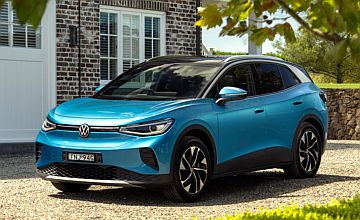Make / Model Search
OptionsCar reviews - Volkswagen - ID - ID.4 Pro and ID.5 GTXVolkswagen modelsOverviewWe like Great seats; ample equipment; plentiful space; polished dynamics; impressive electric range; strong value Room for improvement Functional rather than pretty; steering lacks feedback; boring paint colours; interior plastics solid rather than slick Four years into its life, VW’s electric SUVs launch here wearing a good-value price tag10 Apr 2025 Overview
AS THE first ID-branded, dedicated-electric Volkswagen SUV to launch in Europe, the ID.4 has enjoyed more journeys around the sun than Australians probably realise.
Launched in September 2020, a combination of COVID-affected availability and the lack of a cognisant plan for electric vehicles by the federal government at the time meant that Australia was shunted well down the list when it came to EV access among the Volkswagen Group – particularly the crucial ID.4 electric mid-sized SUV.
Thing was, that first ID.4 wasn’t all it could have been.
So, by the time a change of Australian government (in 2022) brought a newfound focus on encouraging the use of EVs, Volkswagen back in Germany was deeply embedded in developing a comprehensive mid-life update for the ID.4 and its coupe-like cousin, the ID.5 (launched in Europe in late-2021), to silence the critics.
And that’s the ID.4/ID.5 you see here. Launched in Europe in October ’23, this extensive refresh centred around increasing powertrain outputs (the ID.4 Pro’s torque jumped by a whopping 76 per cent), improving battery efficiency and cooling, expanding DC charging capability (now 175kW), and completely revamping the centre touchscreen’s widely panned functionality.
Now measuring 12.9-inches in diameter, the updated touchscreen gets fixed shortcut widgets across the top and permanent HVAC controls along the bottom, plus illuminated temperature sliders beneath that.
It’s also less convoluted in its embedded controls, making life behind the wheel a lot simpler in the ID.4/ID.5 (along with the about-to-launch Golf 8.5).
Another benefit of waiting for the mid-cycle update is the pricing. Launching at $59,990 before on-road costs for the ID.4 Pro single-motor, that’s around $10K less than what was originally predicted.
And yet even the base ID.4 Pro is loaded with standard equipment – as detailed extensively by GoAuto in March – and has only two cost options (metallic paint and a $900 exterior styling pack).
Driving Impressions
Reading through the comprehensive level of standard equipment for the ID.4 Pro and ID.5 GTX, one thing really stands out – the inclusion of adaptive dampers.
It’s a dynamic feature that isn’t available on any of the Volkswagen’s similar-price competitors, yet given the consistent criticism levelled at the ride quality of so many EVs, offering both the ID.4 and ID.5 with standard Adaptive Chassis Control for Australia is the definition of intelligent product planning.
And it proves crucial to the way these electric Volkswagens drive…
Much like a traditional base Golf or an adaptively damped Tiguan on modestly sized wheels, there’s a calming fluency to the way the ID.4 Pro lopes along that effortlessly devours Australian country roads.
Sticking with 19-inch alloy wheels also helps (wearing relatively high-profile 235/55 series tyres up front, and 255/50s at the rear), though offering a 15-setting range for the adaptive damping allows the ID.4/ID.5 to breathe with the surface beneath.
They aren’t perfect, however. They still deflect off bumps on occasion, especially the ID.5 GTX, and become busier around town, even set to ‘Comfort’ mode – but the ID.4/5 don’t suffer from the uncomfortably reactive ride of the related, non-adaptive ID.Buzz people mover.
They corner well, too, with plenty of grip from the rear-drive ID.4 and an effortless keenness when turning into a corner. VW Australia also specified standard Progressive Steering for our market and, again, it’s an inspired move.
With 2.5 turns lock-to-lock spanning quite compact turning circles (10.3m for the single-motor, 11.6m for the GTX), there’s an easy flow to guiding the ID.4/5, even though the steering is better at weighting consistency than transmitting any real feel.
The single-setting regenerative braking fits that vibe as well, blending with the dynamic flavour of both variants.
Of the two, it’s the ID.5 GTX that offers the most entertainment. With the highest outputs (250kW/679Nm) and 80 per cent of its torque driving through the rear wheels, it has an amusing rear bias to it that enhances its driveability in dynamic situations.
It’s at its best in Comfort mode, however, or when set up in Individual mode because the Sport preset makes accelerator response too sensitive and the ride too firm. But if you select ESC Sport, there’s a (safe) tail-happiness about it that can be surprisingly rewarding – even with the damping set towards the comfort spectrum.
The safety electronics prove relatively subtle when putting the brakes on any kind of wayward movement. It’s mainly the lane-keep assistance that natters away at the edges of your driving, though it isn’t too offensive, and it’s easily switched off.
Compared to the often-unrelenting intrusion of the active-safety electronics on most Asian-brand electric SUVs, the Volkswagen’s comparatively calming efficacy is a revelation.
Yet the best aspect about both the ID.4 Pro and the ID.5 GTX is their seats. They’re brilliant. The front pair are ‘ErgoActive’ fully electric buckets upholstered in lovely Microfleece cloth with leatherette outers in the Pro, and full Microfleece sports versions with integrated headrests in the GTX. In both cases, comfort is outstanding.
They also feature two-position memory, three-setting heating, electric four-way lumbar, seatback phone holders and built-in massage, which is highly unusual for both front seats at this price point.
And the rear seat maintains much of that comfort with good under-thigh support and excellent vision, enhanced by a standard all-glass roof with an electric sunblind that actually blocks out harsh Aussie light.
The ID.5 does lose a degree of rear headroom to accommodate its shapely roofline, however it’s not a huge amount, and both Volkswagen EVs feature excellent boots – 543 litres in ID.4 and 549 litres in ID.5.
Powertrain wise, the difference is in the number of electric motors. The rear-drive ID.4 Pro produces an ample 210kW and 545Nm (up from 310Nm in the pre-update model) for an amply brisk 0-100km/h time of 6.7 seconds.
That’s more than enough acceleration for most people, and it’s delivered in a smooth, refined wave, rather than a jolt to the back like turning on a switch.
The dual-motor ID.5 GTX lifts power to 250kW yet maintains the same amount of torque at the rear axle (545Nm). What it adds is another 134Nm on the front axle, hence its considerable all-wheel-drive purchase but obvious rear-end bias when cornering or accelerating hard.
Speaking of which, doubling the electric-motor count reduces VW’s 0-100km/h claim to a deeply satisfying 5.4 seconds – making the GTX the driver’s choice on a great mountain pass.
But if you aren’t particularly keen on ‘coupe SUV’ body styles, VGA will be introducing a GTX version of the ID.4 in the coming months, as well as a rear-drive version of the ID.5.
The GTX also gets a slightly larger battery (79kWh useable compared to 77kWh), meaning it barely suffers when it comes to the combined WLTP range claim.
Volkswagen says the ID.4 Pro is good for 544km – better than all its competitors bar the much less powerful Kia EV5 Air Long Range (555km) – and the ID.5 GTX can manage 522km. The recently launched BYD Sealion 7 Performance AWD offers the same performance as the GTX but is rated at only 456km WLTP.
Based on our efficiency average during enthusiastic driving over some challenging terrain in country New South Wales, the ID.4’s essentially worst-case real-world range is 412km. In urban driving with regenerative braking boosting the battery charge, it shouldn’t be difficult to extract 500km from an ID.4.
A colleague achieved a real-world range figure of 449km in the ID.5 GTX on the drive back to Sydney, at an average of 98km/h, so there’s definitely enough bandwidth in these Volkswagen EVs to (literally) comfortably handle longer distances.
Charging-wise, Volkswagen’s claimed 10-80 per cent charging time of somewhere between 22 and 28mins puts the ID.4/5 towards the more capable end of the medium electric SUV class.
That’s some way behind the benchmark 800-volt Hyundai Ioniq 5 and Kia EV6 charge speeds (18mins each), but some distance ahead of the Mini Countryman SE (29mins), BYD Sealion 7 (32mins), Ford Mustang Mach-E (36mins) and Kia EV5 Long Range FWD (38mins).
Volkswagen includes two charging-cord types as standard, and the first 500 ID.4/ID.5 buyers in Australia will also get an AmpCharge 7kW home charging kit valued at $1899 – the official list price once the deal is finished. That wall-mounted set-up will achieve 10-80 per cent battery charge in 8.5 hours.
All of which continues to add value to what is an impressively strong EV. Volkswagen Australia’s intelligent product planning and undoubted patience appears to have paid off with the ID.4 and ID.5.
While there’s a degree of cost-cutting evident in some of the interior plastics (like many VW models designed in the late-2010s), there’s genuine expense and excellence in the areas that count – such as seat comfort, interior functionality and powertrain ability.
No one is going to buy and ID.4 or ID.5 for their sex appeal. Instead, it’ll be the refined, effortless and suave combination of abilities exuded by this pair of EVs that will ultimately bring buyers to the yard.
They feel like proper Volkswagens, and for many people, that will be enough.
 Read more8th of April 2025  New Volkswagen Amarok Walkinshaw confirmedSuccessful VW/Walkinshaw collab rebooted for second-gen with broader range on the table26th of March 2025  VW gives T-Roc R the Wolfsburg treatmentT-Roc R Wolfsburg Edition joins Volkswagen line-up priced from $69,290 +ORC11th of March 2025  VW backflips on in-cabin hard buttonsHaptic controls out buttons back in for Volkswagen saying, it’s a car not a phoneAll car reviews Alfa Romeo Alfa Romeo Abarth Abarth Audi Audi Aston Martin Aston Martin BMW BMW Bentley Bentley Chrysler Chrysler Chevrolet Chevrolet Dodge Dodge Citroen Citroen Ferrari Ferrari DS DS Ford Ford Fiat Fiat FPV FPV Foton Foton Haval Haval Great Wall Great Wall Honda Honda Holden Holden Hyundai Hyundai HSV HSV Isuzu Isuzu Infiniti Infiniti Jaguar Jaguar Iveco Iveco Kia Kia Jeep Jeep Land Rover Land Rover Lamborghini Lamborghini Maserati Maserati Lexus Lexus McLaren McLaren Mazda Mazda Mercedes-Benz Mercedes-Benz Mitsubishi Mitsubishi Mini Mini Opel Opel Nissan Nissan Porsche Porsche Peugeot Peugeot Ram Ram Proton Proton Rolls-Royce Rolls-Royce Renault Renault Skoda Skoda Saab Saab SsangYong SsangYong Smart Smart Suzuki Suzuki Subaru Subaru Toyota Toyota Tesla Tesla Volvo Volvo |
OptionsClick to share
|











Facebook Twitter Instagram